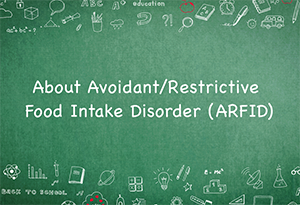What Is ARFID?
Psychotherapist
Specialty Care Center
Avoidant/Restrictive Food Intake Disorder (ARFID) is an eating disorder whose main feature is restricting food intake. This disorder is also associated with difficulties meeting nutritional needs.
This food avoidance can occur for three different reasons:
- It can occur because an individual is not interested in food.
- The individual may avoid eating because they are more sensitive to the taste, smell or texture of food. This presentation of ARFID has been described as “restrictive” or “choosy eating.” However this is different from typical picky eating often seen in toddlers.
- Another reason they may restrict their food is because they have fears about eating such as worries they will choke or vomit. These fears often occur following a distressing eating experience or medical procedure.
ARFID can present in three different ways:
- Sensitivity to the taste, smell, or texture of foods.
- An apparent lack of interest in food and eating.
- Fear of consequences of eating such as stomach pains, vomiting, or choking.
This disorder occurs commonly in infancy or childhood and can continue into adulthood. Often times, avoidance due to sensory characteristics of food occurs in early childhood. Avoidance due to aversive consequences of eating can occur at any time throughout an individual’s life, for example, after having a choking experience. ARFID does occur more often in childhood and sometimes the parent-child interaction can contribute to the infant’s or child’s feeding problem.
What to Watch for
- Lack of interest in food and eating
- Weight loss or growth faltering
- Dependence on nutritional supplements
- Nutritional deficiencies (ex. Vitamin or folate deficiencies)
- Avoiding eating opportunities
- Difficulties eating with others
- Expressed desire to improve eating, but difficulties doing so
- Anxiety around food and eating
What to Do if You Expect Your Child or Loved One Is Experiencing Difficulties With Eating
- Consult your health care provider or contact the Eating Disorders Program. Seek professional help from an eating disorder treatment team that provides cognitive behavioral therapy and utilizes the Satter Feeding Dynamics Model. Learn more about the Satter Division of Responsibility.
- Continue to offer a variety of foods, providing accommodation will maintain difficulties with eating.
- It is best to avoid applying pressure during meal times, if you are concerned about your child’s growth, seek professional help.
- Provide structured meals and snacks throughout the day.
- Talk to your loved one about your concerns with their eating and offer to assist them with scheduling an appointment.
- Following guidelines for childhood feeding based on the Satter Feeding Dynamics Model will help your child become a competent eater and can serve as a protective factor against the development of an eating disorder.
Additional Resources
- Feeding with Love and Good Sense offered by Jennifer Harris, RDN, RD, CEDRD. Learn more and register online now.
- Review the book Child of Mine: Feeding with Love and Good Sense by Ellyn Satter
- If you suspect someone you love is showing signs of an eating disorder, don’t delay in consulting with your heal care provider or contact the Eating Disorders Program
Sources:
American Psychiatric Association. Diagnostic and Statistical Manual of Mental Disorders. 5th Edition. Washington, DC: American Psychiatric Association, 2013.
Satter E. What is ARFID and what does it have to do with feeding dynamics and eating competence? Family Meals Focus 89. Ellen Satter Institute Website 2015.
Thomas, J.J., Lawson, E.A., Micali, N. et al. Avoidant/restrictive food intake disorder: a three-dimensional model of neurobiology with implications for etiology and treatment. Curr Psychiatry Rep. (2017) 19:54.
Zimmerman J, Fisher M. Avoidant/Restrictive Food Intake Disorder (ARFID). Curr Probl Pediatr Adolesc Health Care (2017) 47:95-103.
